
02 May A Bold New Canvas
Sixty middle school children shuffle through a white concrete museum gallery flanked by paintings of Indigenous life, woven baskets and beaded bottles—some old, some new. Indigenous art, depicting a life separate from today’s urban culture, connects them to a larger, more magnificent world than they had previously imagined. On the floor above, a dark, mysterious gallery dominated by ichthyosaur fossils transports them back 250 million years.
It may sound like a typical jaunt through seasonal exhibits at the Nevada Museum of Art in downtown Reno, but it is only a snippet of something entirely new.
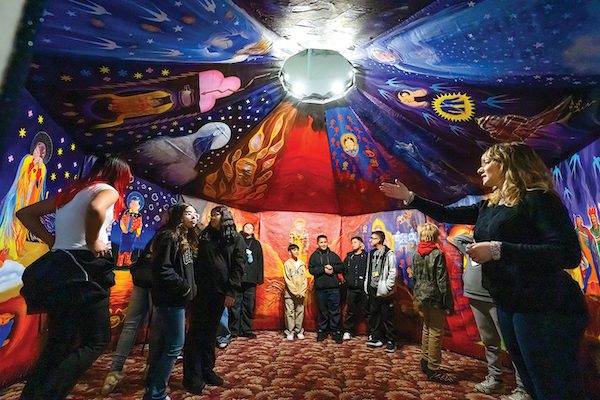
Bonnie Blair Lacy, Nevada Museum of Art education coordinator, gives Desert Skies Middle School students a tour of The Art of Judith Lowry exhibit at the museum
“I’m not going to say it’s a big museum, but it’s now more than a midsize museum,” says Nevada Museum of Art CEO David Walker. “When you’re looking from one side of the hall to the other, the scale really takes my breath away at times.”
The museum’s staff, board and donors have been working toward a $60 million expansion for eight years. The new 50,000-square-foot Charles and Stacie Mathewson Education and Research Center seamlessly connects to the original hard, black sculptural structure. It will open one floor at a time this year, from March to August.
A visitor can stand at the edge of the original building’s north wall and peer across a city block, or 300 feet, to the south wall of the expansion. The newest gallery, currently showcasing The Art of Judith Lowry through November, demonstrates endless possibilities through a combination of hanging art, glass displays, interactive iPads and a walk-in yurt.
The expansion nearly doubles the original square footage of Nevada’s only accredited art museum. While it certainly provides more walls and shelves for art of all kinds, it also adds a research library, creates new spaces for education and strengthens a deep connection with Indigenous peoples on this side of the globe.
More Art in More Places
“Part of the expansion wasn’t to build more storage, but to build more galleries so the permanent collection can be viewed,” Walker explains.
Before the expansion, the museum’s growing collection was hidden throughout the building and even stored off-site. Now, 50 percent of that collection will be on display permanently.
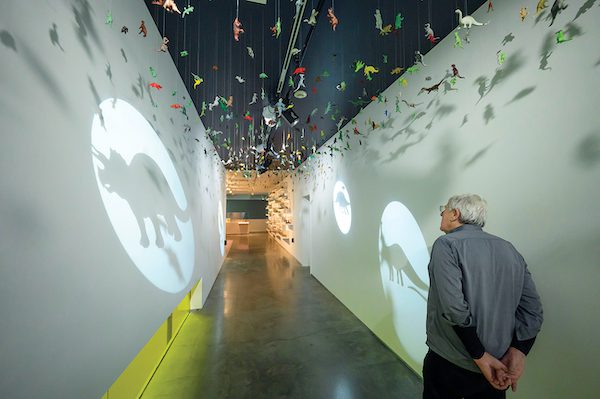
An exhibit of the largest plastic dinosaur collection in North America at the Nevada Museum of Art
The expansion allows for more compartmentalized experiences, encouraging repeat visits. Museum staff can now close small sections at a time and stagger exhibit openings, eliminating the need to shut down the entire museum for seasonal installations.
The second floor displays a few exhibits dedicated to regional artwork and donated collections, while the third floor often showcases more extensive traveling exhibits. A visitor can usually explore the entire museum in an afternoon. However, the enlarged second-floor gallery now gives way to another room dedicated to Desert Dialogues. Featuring photographs of global desert landscapes, this space will eventually transform into a classroom for art students at the University of Nevada, Reno.
On the third floor, one exhibit hall gives way to another of a different shape and size, and if a visitor walks far enough, they will step out onto a second, separate roof to discover sculptures and a garden.
The original building, designed by architect Will Bruder, provided a somewhat linear experience centered on the grand staircase. The expansion, also designed by Bruder, will offer a more meandering, serendipitous flow.
Expanding Art Education
While the Nevada Museum of Art’s internal geography adds value for visitors, its research- and education-based mission, combined with an art and environment focus, sets it apart and expands its vision, capabilities and international footprint.
“The museum is many things to many people, and one of the most important ways the museum is known nationally and internationally is for the Institute for Art + Environment,” says Colin Robertson, the Charles N. Mathewson senior vice president of education and research.
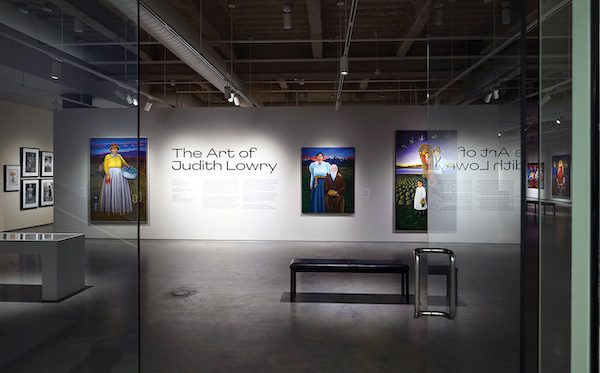
The Art of Judith Lowry is a new Native American collection in the Nevada Museum of Art’s expanded second floor gallery
The museum has focused on the environment since it was established in 1931, when founder Dr. James Church invented the Mount Rose Snow Sampler, still used today to measure water content in snow. Over the past nine decades, the museum has amassed collections and collaborated with artists to explore the intersection of art and climate science.
The Thomas and Pauline Tusher Library, on the first floor of the expansion, will provide free access to a dense collection of work discussing the intersection of climate science and climate change and its cultural impact. The library will not allow books or art to leave the premises, but people can conduct research and interact with the pieces as much as they want inside.
“We currently have 230 or so project-based archives that are materials, documents and items that serve as primary sources created by artists or people studying work related to environmental topics,” Robertson says.
One such archive includes materials related to Cannupa Hanska Luger’s mirror shields, used by Water Protectors at Standing Rock during the 2016 Dakota Access Pipeline protests. The mirrors reflected the image of law enforcement back at themselves and protected the protesters from batons, tear gas and pepper spray.
“What I’m trying to do is activate those materials in a much more dynamic way than academic use alone. We want to expand who has access to those materials,” says Robertson, including expanding educational opportunities to local schools.
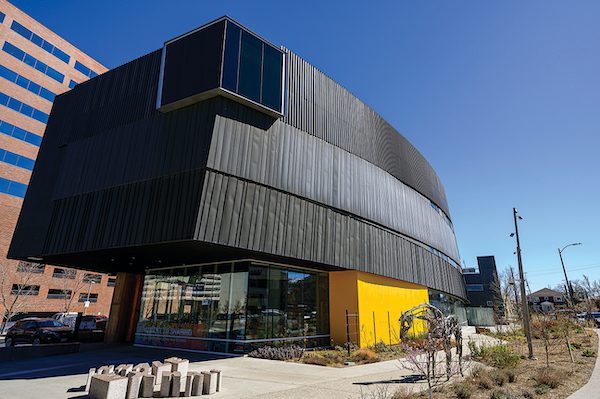
Will Bruder designed the original Nevada Museum of Art building, which opened in 2003, around a Black Rock motif. The mixed textures, sweeping curve and touches of color evoke a natural desert landscape
“We’ve become an increasingly important part of the region’s education ecosystem,” Walker adds.
Last year, 7,000 K-12 students toured the museum during field trips. Robertson hopes to grow that to 10,000 annually by 2028. The new research library, additional gallery space, classrooms and commitment to partnerships with regional educators should drive that number up.
“That’s 10 percent of the student body of Washoe County schools,” he says. “So that’s good, but we must do better as a community. There’s a lot of evidence—written scientific data-driven evidence—that shows the merit and benefit of high-quality art education that helps improve outcomes in other fields.”
In April, the museum hosted an NV STEAM conference and Washoe County School District librarian retreat. Educators earn continuing education credits, which can help maintain their licenses and even boost salaries. The programs are free, and the museum provides these opportunities because there are no certified art specialists in the district.
This fall, the Desert Dialogues room will host a new UNR survey course on field methods for artists. This course initiates a proposed minor that focuses on art and the environment. The next course will explore how the brain interacts with art in nature.
“I’m very fascinated by that because there’s a lot of evidence to support the idea that art is a powerful vessel for social and emotional learning,” Robertson says. “Art is a social tool for the epidemic of loneliness that has existed for many years but has been exacerbated by technology.”
All students of any regional education institution receive free day-pass admission to the museum. In addition, K-12 teachers can obtain a free annual membership thanks to an endowment program. The museum will also continue its on-site community learning program at the E.L. Cord Museum School, which hosts open classes spanning various hands-on topics, from watercolors and drawing to photography and digital illustration.
The Indigenous Landscape
The museum’s mission and expansion drive its inclusion of and connection to Indigenous people worldwide.
“We feel a deep connection and responsibility to these communities, particularly to the artists who are leaders in their communities,” Walker says, noting that many people turn to elders in Indigenous communities for advice and counsel on how they have survived climate change for centuries.
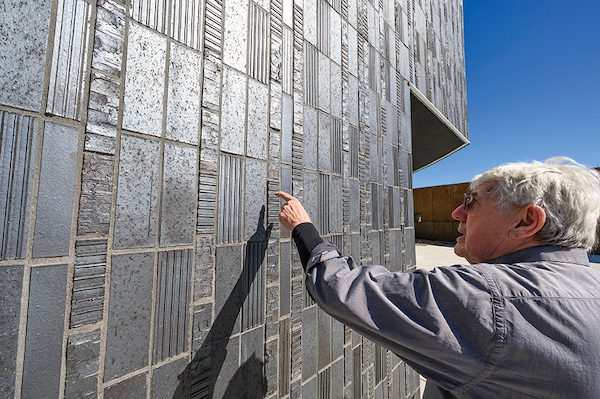
Will Bruder points to the tile work on the exterior of the Nevada Museum of Art expansion. The random patterns of the tiles are one of his favorite details
He explains that the climate of the West is shared by a super region that stretches from Alaska to South America and from the Rockies to Australia.
“Sometimes scientists will call a tribe and want to speak to someone about climate change, but no one is offering them any money,” Walker says. “We spend a lot of time raising money to ensure we’re not taking something that has value for free.”
Walker sees the museum as a place to host dialogues that bring together cultures, art, environmental issues and people.
“We want this to be a default place where ideas can be discussed and argued,” he says. “And the best way to make a point and have a discussion is by seeing the art on the wall. Artists teach us so much. Giving those artists a voice is exciting. It drove me to add more galleries and more space for this museum and make these voices louder and larger.”
On the new roof, the Henry Luce Foundation Indigenous Interpretive Garden deepens the museum’s physical relationship to the art and environment mission.
It aims to educate communities about Indigenous ecological knowledge and its relevance to understanding and combating climate change, living more harmoniously with the earth and fostering sustainable relationships with the environment, according to the museum.
The garden was created with Indigenous communities, including the Great Basin region’s three cultural groups—Numu (Northern Paiute), Wášiw (Washoe) and Newe (Western Shoshone)—to honor their wisdom, preserve traditional ecological knowledge and amplify it for a broader audience. Its plants are all used in basketry, connecting the garden to the permanent collection.
“The rooftop Indigenous garden will be an exciting opportunity to engage with native plants from three zones, or micro-environments, growing in Nevada,” says Melissa Melero-Moose, a Northern Paiute artist and Native American adviser to the Nevada Museum of Art. “This will be a unique way to connect the importance of these plants to Indigenous knowledge, basketry uses and all of our community’s connections to the land.”
A Physical Connection to Nevada
Architect Will Bruder runs his fingers across the textured tiles of the expansion’s exterior walls. He points to a series of ridged lines—tiles flipped over to expose the side commonly used for glue.
“You can see the continuous random pattern of the new ceramic tiles,” Bruder explains. “And they’re sort of like belly buttons, so we have innies and outies. On a third of that wall, all the tiles are hung backward. That’s where you get the various textures.”
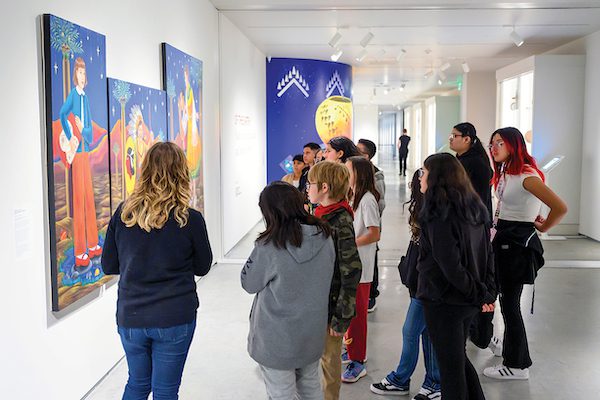
Bonnie Blair Lacy, the museum’s education coordinator, gives Desert Skies Middle School students a tour of The Art of Judith Lowry exhibit, which will remain on display through November 2025
Suddenly, it’s obvious how many tiles on the skin of the building are flipped and placed in a random order. There is no pattern. Traditionally, an architect would provide a drawing to create a uniform look, but Bruder told the artisans to make it their own.
The rough black exteriors, punctuated by “pungently optimistic green,” don’t match the original structure built in 2003, drawing attention to the new and old rather than trying to make the expansion appear as if it has always been there. The connection to Nevada’s Black Rock Desert cannot be understated or missed.
The windows on the exterior wall appear randomly placed because they are, yet they still provide ample natural light within each of the new galleries. The rusted metal railings continue the style of the extruded steel on the north side of the original building but will take several years to patina. Silvery steel on the back side hearkens to the state’s official metal.
Inside the new research library, a bristlecone pine clock designed by Jonathon Keats reminds visitors of their connection to the planet and variable views of time. A sister clock sits on the side of Mount Washington near Great Basin National Park. The clock is calibrated to a 5,000-year calendar, represented by the ancient tree rings. Two pendulums in the clock swing at a “very beautiful and meditative pace,” Robertson says, meant to evoke thoughts on longevity and the sustainability of life.
“When the oldest living bristlecone pine trees were sprouts, humans did not yet have metal tools as a civilization,” he says. “We might learn how to live on earth a little better if we studied the ways of the bristlecone pine.”
The third-floor gallery expansion opens May 31, and the first-floor library opens in the summer once the final custom shelving has been installed.
One of Mike Higdon’s first articles in college was about the chair exhibit at the Nevada Museum of Art in 2007. These days, you can find him taking pictures and telling stories around Reno for his new business, Mike Higdon’s Storytelling Studio.



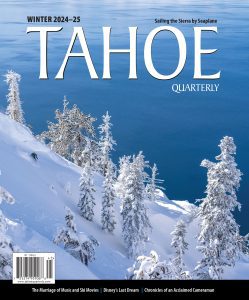
No Comments